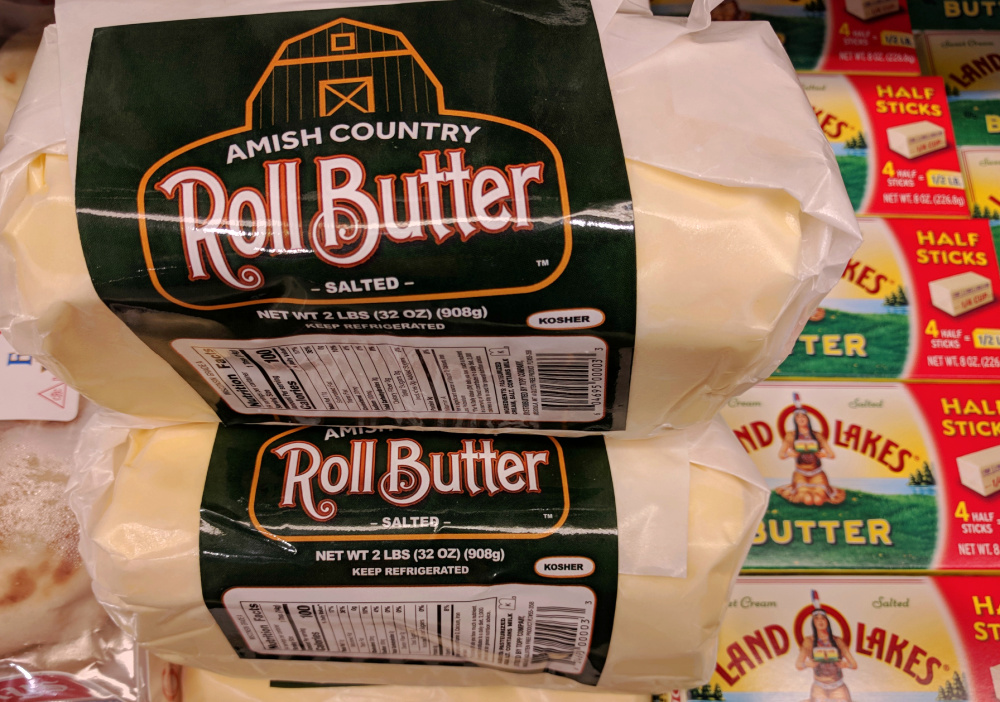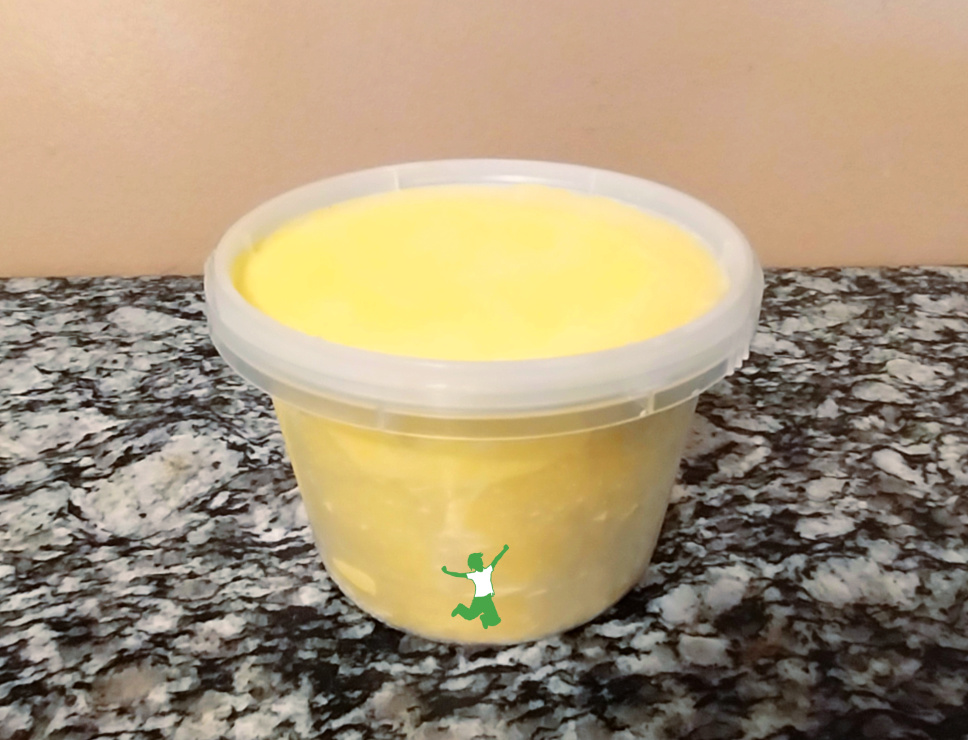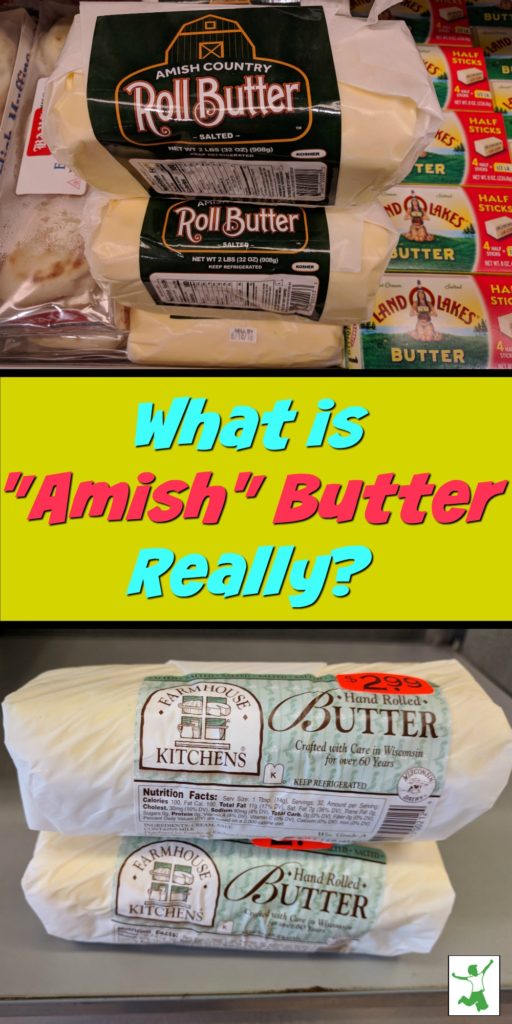How to tell the difference between real and fake rolls of Amish butter and how each compares with supermarket butter.

It used to be that glitzy packaging and prime shelf space lured consumers to buy a product the most effectively.
In recent years, however, it seems that a popular way to sell processed food is to “dress it down” so the product resembles something homemade or an item from a farmer’s market.
What is Amish Butter?
Hence, the advent of rolled “Amish butter” humbly hand-wrapped in parchment paper.
It’s not whipped butter, but rather a solid block or “roll”.
This approach works particularly well with consumers who understand the importance of homemade and traditional foods.
However, these same people, for whatever reason, usually have no “dirt under their nails” either producing some of their own food or dealing directly with local farmers who do.
This scenario can lead to a more intellectual approach to Real Food. In other words, understanding the problem with little to no practical, on the ground knowledge of how food is produced.
While there is nothing wrong with this, it leaves a person vulnerable to food scams. Understanding only that factory fare is to be avoided, that the Food Pyramid is a joke, and that old-fashioned, minimally processed foods like butter are better is usually not enough!
You have to …. forgive the overly used phrase … know your farmer.
This gap in knowledge between what nutrient-dense foods are and how they are actually produced is what food manufacturers exploit in a big way.
How Many Amish Farms Needed to Supply Costco?
You knew it was bound to happen, right?
As the popularity of old fashioned butter rose, so did attempts by conventional food manufacturers to cash in.
One approach that has really gone cha-ching for large commercial dairy companies is the marketing of Amish butter, also called hand-rolled butter or simply butter rolls.
Your first clue that this stuff isn’t what it claims is the mere fact that it is everywhere. For example, nearly every large supermarket chain in my large metro area carries it.
Mmmm. Let’s think about this for a minute…
The truth is that there aren’t enough small, grass-fed Amish dairy farms in the entire United States to produce enough quality butter to supply supermarkets.
We would need a return to the millions of family farms that existed prior to WWII for this to happen!
REAL Amish Butter
REAL Amish butter is a niche product much like the market for healthy butter substitutes.
You buy it directly at an Amish farm, at a farmer’s market, or from a local food club.
Some small health food stores might carry small quantities of locally produced tubs.
One thing is for sure.
Butter made from the milk from cows grazing on Amish family farms is NOT going to be a widely distributed product let alone delivered on enormous SYSCO trucks and stocked on the shelves of mega supermarket chains!
What is Rolled Butter Really?
If Amish roll butter isn’t really from small, grass-fed Amish dairy farms, then what is it?
According to an employee of a company that makes rolled butter, Amish butter is really just large slabs (in this case, 40 pounds each) of commercial butter cut and wrapped in parchment paper by Amish employees.
That’s it.
Basically, the Amish butter at your supermarket is no better than other widely available butter brands such as Land O’Lakes.
The price indicates the same. At my local supermarket, 2-pound rolls of “Amish butter” is comparable in price/ounce to the generic supermarket brand, which is just smaller in size. Do the math.
By comparison, commercial “Amish butter” is about half the price of gourmet butters like Kerry Gold.
Fake Amish butter is also about one-third the price of real Amish grass-fed butter. More on that below.
Basically, roll butter is basically the same pale yellow as supermarket butter. This indicates a low amount of fat-soluble vitamins (zero Vitamin K2) and that the cream likely came from conventional (GMO) grain-fed cows.
One other problem I can’t explain. When a package of at least one brand of roll butter I tested is kept at room temperature, it doesn’t soften!
The ingredients only list “pasteurized cream and salt”. So, I’m not quite sure what is going on or what unlabeled additive(s) are at play.
All I can tell you is that real butter softens on the counter!
Color Doesn’t Lie!
If you learn to make homemade butter or buy it from a small grass-fed dairy farm, you will see firsthand the scam of hand-rolled butter.
Freshly made, artisanal butter isn’t “rolled” (aka, cut in round or oval chunks). It is scooped and packaged into tubs while still soft from churning!
The only way it would be “rolled” is if a machine shaped it into a large slab, it was chilled until hard, and then cut and wrapped probably on a factory line of some kind.
In other words, “hand-rolled butter” doesn’t mean that it is quality butter (although theoretically, it could be). It is just a description of the butter packaging process. Nothing more.
Small grass-fed dairy farmers typically package real Amish butter in one pound tubs. It is also very yellow and quite expensive – usually about three times the price of commercialized Amish butter.
Here’s a picture of the REAL Amish butter in my refrigerator so you can see the difference!

Beware of Butter Fakery at Farmers Markets
Here’s another tip. I’ve seen the same “Amish butter” available at supermarkets being hawked at farmer’s markets too.
It seems to be an extension of the problematic trend of small businesses buying conventional produce (same as in a supermarket) and selling at farmers markets or roadside stands and passing it off as local.
In sum, Amish roll butter is certainly a better choice than margarine, and if that is what fits your budget, then buy it.
Just don’t be fooled by the clever branding!
Rolled butter isn’t the down-home, country-made product suggested by the name and the packaging.
If you want real Amish butter, you won’t be finding it at the grocery store.
You get what you pay for.
Supermarket price? Supermarket butter.









Do you know if Minerva Dairy rolled Amish butter, sold by Azure Standard, is the real deal?
Minerva Dairy is not an Amish farm. It is a mega-company with an annual revenue of over 26 million dollars! It sources *some* of its milk from Amish farms and cuts the commercial butter in rolls, aka “Amish-style”, but that’s it.
Now, that you mentioned the colour…I wouldn’t put past the corporate fake Amish butter producers to put a bit of colour in the butter. A touch a carotene can do miracles for the pale nondescript butter…Yes, I am being sarcastic! “ USA: β -carotene (natural and synthetic) is exempt from certification…” I just copied from the internet.
Know your farmer seems to be very important indeed!
As someone who has had there own cow for almost 30 years and made lots of butter over the years I think that I have an insight to the butter that stays firm in the counter. I remember the older woman who taught me a lot about having a cow and doing our own dairy products saying that we wished we could have winter butter in the summer. When she said that there were a lot of things going on and I didn’t ask her what she meant. But over the years as I experienced making and using my own grassfed butter I would often think of her words. The butter made from cream that comes from cows in the winter is definitely more firm than summer made butter. And it’s not because my kitchen is colder either. We have a wood stove and a very warm kitchen. Another interesting fact is that the night before the temperature drops to zero or below the cows produce a lot more cream! God created their bodies to know that their calves would need higher fat to help survive the extra cold. On extra cold mornings I would find my milk jars from the night before almost half cream!!
Why is it that REAL butter is so expensive in America? I watch these videos of cooks and bakers overseas and their butter is universally of better quality than the normal butter I can get due to monetary constraints. I once asked how much their butter cost then calculated it back into US dollars and came up with roughly $2.50 a pound. So why is it they can have butter that is richer and better and still maintain a lower cost, yet something like Kerry Gold costs over $6.50 or so and that is one of the less expensive higher end butters sold here in the States. It’s not that I think people in other countries should not have theses things, I just want to know what it is they are doing right and what we are doing so very wrong and is it possible to fix what is going so we can get better quality dairy products here in the US for a more reasonable price.
Aldi and Lidl have unsalted butter for $ 2.38 per pound. I use it for baking. The same stores have Irish butter for $ 3.69 per half pound. It tastes as good as Kerrygold.